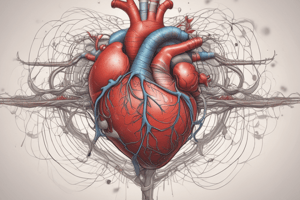Podcast
Questions and Answers
What does the left ventricle do?
What does the left ventricle do?
- Receives deoxygenated blood from the body
- Takes oxygenated blood from the lungs to the left atrium
- Pumps blood to the lungs
- Pumps blood through the aorta to the rest of the body (correct)
What does the right atrium receive?
What does the right atrium receive?
Deoxygenated blood from the body
What is the function of the right ventricle?
What is the function of the right ventricle?
Pumps blood to the lungs
What is the role of the aorta?
What is the role of the aorta?
What does the left atrium do?
What does the left atrium do?
What does the superior vena cava do?
What does the superior vena cava do?
What carries deoxygenated blood from the right ventricle to the lungs?
What carries deoxygenated blood from the right ventricle to the lungs?
What does the inferior vena cava do?
What does the inferior vena cava do?
What does the pulmonary vein do?
What does the pulmonary vein do?
What is the function of the mitral valve?
What is the function of the mitral valve?
Where is the aortic valve located?
Where is the aortic valve located?
What does the pulmonary valve do?
What does the pulmonary valve do?
What is the function of the tricuspid valve?
What is the function of the tricuspid valve?
Flashcards are hidden until you start studying
Study Notes
Heart Anatomy and Function
- Left Ventricle: Essential for pumping oxygen-rich blood through the aorta to supply the entire body.
- Right Atrium: Receives deoxygenated blood coming back from the body, acting as the heart's entry chamber for used blood.
- Right Ventricle: Responsible for pumping deoxygenated blood into the lungs for oxygenation, crucial for the respiratory circulation.
- Aorta: The body's largest artery that ensures the distribution of oxygenated blood from the left ventricle to the various organs and tissues.
- Left Atrium: Functions as the receiving chamber for incoming oxygenated blood from the lungs via pulmonary veins.
Major Blood Vessels and Circulatory Pathways
- Superior Vena Cava: Carries deoxygenated blood from the upper part of the body to the right atrium, facilitating blood return to the heart.
- Inferior Vena Cava: Similar to the superior counterpart, but specifically transports blood from the lower regions of the body to the right atrium.
- Pulmonary Artery: Unique for carrying deoxygenated blood from the right ventricle to the lungs, involved in the pulmonary circuit for gas exchange.
- Pulmonary Vein: Responsible for transporting oxygenated blood from the lungs back to the left atrium, completing the oxygenation cycle.
Heart Valves
- Mitral Valve: Positioned between the left atrium and left ventricle, ensures one-way blood flow and prevents backflow during ventricular contraction.
- Aortic Valve: Located at the exit of the left ventricle, allowing blood flow into the aorta while preventing backflow into the ventricle.
- Pulmonary Valve: Found between the right ventricle and pulmonary arteries, it regulates blood flow to the lungs and prevents backflow into the ventricle.
- Tricuspid Valve: This valve resides between the right atrium and right ventricle, ensuring blood moves in one direction and prevents backflow during contraction.
Studying That Suits You
Use AI to generate personalized quizzes and flashcards to suit your learning preferences.




